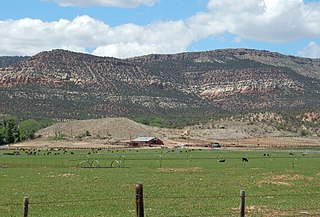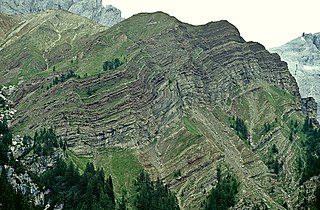
An evaporite is a water-soluble sedimentary mineral deposit that results from concentration and crystallization by evaporation from an aqueous solution. There are two types of evaporite deposits: marine, which can also be described as ocean deposits, and non-marine, which are found in standing bodies of water such as lakes. Evaporites are considered sedimentary rocks and are formed by chemical sediments.

The Permian Basin is a large sedimentary basin in the southwestern part of the United States. It is the highest producing oil field in the United States, producing an average of 4.2 million barrels of crude oil per day in 2019. This sedimentary basin is located in western Texas and southeastern New Mexico.

Gaylussite is a carbonate mineral, a hydrated sodium calcium carbonate, formula Na2Ca(CO3)2·5H2O. It occurs as translucent, vitreous white to grey to yellow monoclinic prismatic crystals. It is an unstable mineral which dehydrates in dry air and decomposes in water.

Zabuyelite is the natural mineral form of lithium carbonate, with a formula Li2CO3. It was discovered in 1987 at Lake Zabuye, Tibet, after which it is named. It forms colorless vitreous monoclinic crystals.
The Kaskaskia sequence was a cratonic sequence that began in the mid-Devonian, peaked early in the Mississippian, and ended by mid-Mississippian time. A major unconformity separates it from the lower Tippecanoe sequence, called the "Wallbridge Unconformity".

A sabkha is a coastal, supratidal mudflat or sandflat in which evaporite-saline minerals accumulate as the result of semiarid to arid climate. Sabkhas are gradational between land and intertidal zone within restricted coastal plains just above normal high-tide level. Within a sabkha, evaporite-saline minerals sediments typically accumulate below the surface of mudflats or sandflats. Evaporite-saline minerals, tidal-flood, and aeolian deposits characterize many sabkhas found along modern coastlines. The accepted type locality for a sabkha is at the southern coast of the Persian Gulf, in the United Arab Emirates. Evidence of clastic sabkhas are found in the geological record of many areas, including the UK and Ireland. Sabkha is a phonetic transliteration of the Arabic word used to describe any form of salt flat. A sabkha is also known as a sabkhah,sebkha, or coastal sabkha.
The Manitoba Group is a stratigraphical unit of middle to late Devonian age in the Western Canadian Sedimentary Basin.

In geology, the Paradox Formation Is a Pennsylvanian age formation which consists of abundant evaporites with lesser interbedded shale, sandstone, and limestone. The evaporites are largely composed of gypsum, anhydrite, and halite. The formation is found mostly in the subsurface, but there are scattered exposures in anticlines in eastern Utah and western Colorado. These surface exposures occur in the Black Mesa, San Juan and Paradox Basins and the formation is found in the subsurface in southwestern Colorado, southeastern Utah, northeastern Arizona and northeastern New Mexico.

The Magnesian Limestone is a suite of carbonate rocks in north-east England dating from the Permian period. The outcrop stretches from Nottingham northwards through Yorkshire and into County Durham where it is exposed along the coast between Hartlepool and South Shields. The term has now been discontinued in formal use though it appears widely in popular and scientific literature on the geology of northern England.
The Raman oil field is an oil field located in Batman, Batman Province, Southeastern Anatolia Region, Turkey. It was discovered in 1940 and later developed by Türkiye Petrolleri Anonim Ortaklığı. It began production in 1948 and produces oil. The total proven reserves of the Raman oil field are around 400 million barrels (55×106tonnes), and production is centered on 4,000 barrels per day (640 m3/d).
The Batı Kozluca oil field is an oil field located in Batman, Batman Province, Southeastern Anatolia Region. It was discovered in 1978 and developed by Türkiye Petrolleri Anonim Ortaklığı. It began production in 1980 and produces oil. The total proven reserves of the Batı Kozluca oil field are around 138 million barrels (18.8×106tonnes), and production is centered on 1,500 barrels per day (240 m3/d).
The Adıyaman oil field is an oil field located in Adıyaman, Adıyaman Province, Southeastern Anatolia Region. It was discovered in 1982 and developed by Türkiye Petrolleri Anonim Ortaklığı. It began production in 1985 and produces oil. The total proven reserves of the Adıyaman oil field are around 72 million barrels (9.8×106tonnes), and production is centered on 800 barrels per day (130 m3/d).
The Dinçer oil field is an oil field located in Batman, Batman Province, Southeastern Anatolia Region. It was discovered in 1988 and developed by Türkiye Petrolleri Anonim Ortaklığı. It began production in 1990 and produces oil. The total proven reserves of the Dinçer oil field are around 55 million barrels (7.5×106tonnes), and production is centered on 400 barrels per day (64 m3/d).
The İkiztepe oil field is an oil field located in Batman, Batman Province, Southeastern Anatolia Region. It was discovered in 1988 and developed by Türkiye Petrolleri Anonim Ortaklığı. It began production in 1990 and produces oil. The total proven reserves of the İkiztepe oil field are around 53 million barrels (7.2×106tonnes), and production is centered on 400 barrels per day (64 m3/d).

Lawrence Alexander Hardie was an American geologist, sedimentologist, and geochemist.

The Bangor Limestone is a fossil bearing Mississippian geologic formation in northern Alabama. It is a shallow marine carbonate formation in the Chesterian series.

Gerald M. Friedman (1921–2011) was a distinguished professor in Geology and was one of the founders of modern rock sedimentation. Friedman was a professor in Rensselaer Polytechnic Institute, the Graduate Center of the City University of New York and Brooklyn College.

The Lusitanian Basin is a rift basin remnant located on both the mainland and continental shelf off the west-central coast of Portugal. It covers an area measuring 20,000 square kilometres (7,700 sq mi) and extends north-south from Porto to Lisbon. The basin varies between approximately 130 kilometres (81 mi) and 340 kilometres (210 mi) in width and belongs to a family of periatlantic basins such as the Jeanne d'Arc Basin. To the east of the Lusitanian Basin lies the Central Plateau of the Iberian Peninsula. A marginal horst system lies to the west. The Alentejo and Algarve Basins connect to the southern end of the Lusitanian Basin. In the north, it connects to the Porto and Galicia Basins via an undersea ridge.
The geology of the United Arab Emirates includes very thick Paleozoic, Mesozoic and Cenozoic marine and continental sedimentary rocks overlying deeply buried Precambrian. The region has extensive oil and gas resources and was deformed during the last several million years by more distant tectonic events.

The geology of Italy includes mountain ranges such as the Alps and the Apennines formed from the uplift of igneous and primarily marine sedimentary rocks all formed since the Paleozoic. Some active volcanoes are located in Insular Italy.












